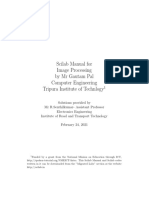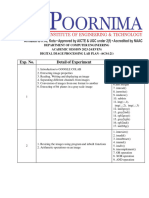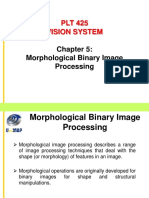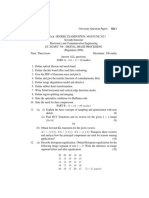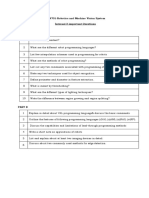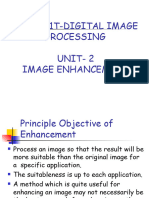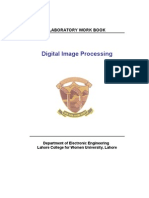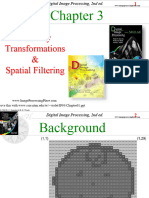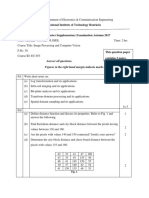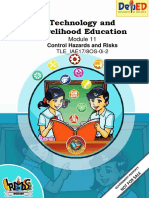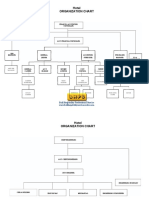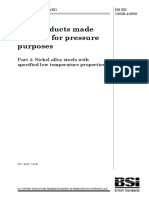Course Course Course L T P C
21CSE454T COMPUTER VISION E PROFESSIONAL ELECTIVE
Code Name Category 2 1 0 3
Pre-requisite Co- requisite Progressive
Nil Nil Nil
Courses Courses Courses
Course Offering Department School of Computing Data Book / Codes / Standards Nil
Course Learning Rationale (CLR): The purpose of learning this course is to: Program Outcomes (PO) Program
Specific
CLR-1: introduce students the foundations of Image Processing Techniques 1 2 3 4 5 6 7 8 9 10 11 12 Outcomes
CLR-2: understand the shape and region analysis
Individual & Team Work
Engineering Knowledge
Design/development of
Project Mgt. & Finance
Conduct investigations
of complex problems
CLR-3: understand the Hough Transform and its applications to detect lines, circles, ellipses
Modern Tool Usage
Life Long Learning
The engineer and
Problem Analysis
Communication
CLR-4: understand the Three-dimensional image analysis techniques and Motion Analysis
Environment &
Sustainability
CLR-5: study some applications of computer vision algorithms
solutions
society
PSO-1
PSO-2
PSO-3
Ethics
Course Outcomes (CO): At the end of this course, learners will be able to:
CO-1: perform basic Point detection and Morphology 3 - - - - - - - - - - - - - -
perform shape analysis, implement boundary tracking techniques and a apply chain codes and other region
CO-2: 2 2 1 - - - - - - - - - 3 - -
descriptors
CO-3: apply Hough Transform for line, circle, and ellipse detections 3 2 1 - 1 - - - - - - - 3 - -
CO-4: apply 3D vision techniques Implement motion related techniques 2 - - - - - - - - - - - 3 - 2
CO-5: develop applications using computer vision techniques 2 - 1 1 1 - - - - - - - 3 - 2
Unit-1 - Image Processing Foundations 9 Hour
Image processing techniques - classical filtering operations - thresholding techniques - edge detection techniques - corner and interest point detection - mathematical morphology - texture.
Unit-2 - Shapes and Regions 9 Hour
Binary shape analysis – connectedness – object labeling and counting – size filtering – distance functions – skeletons and thinning – deformable shape analysis – boundary tracking procedures – active contours –
shape models and shape recognition – centroidal profiles – handling occlusion – boundary length measures – boundary descriptors – chain codes – Fourier descriptors – region descriptors – moment.
Unit-3 - Hough Transform 9 Hour
Line detection – Hough Transform (HT) for line detection – foot-of-normal method – line localization – line fitting – RANSAC for straight line detection – HT based circular object detection – accurate center location
– speed problem –ellipse detection – Case study: Human Iris location – hole detection – generalized Hough Transform (GHT) – spatial matched filtering – GHT for ellipse detection – object location – GHT for feature
collation.
Unit-4 - Vision and Motion 9 Hour
Methods for 3D vision – projection schemes – shape from shading – photometric stereo – shape from texture – shape from focus – active range finding – surface representations – point-based representation –
volumetric representations – 3D object recognition – 3D reconstruction – introduction to motion – triangulation – bundle adjustment – translational alignment – parametric motion – spline-based motion – optical flow
– layered motion.
Unit-5 - Applications 9 Hour
Application: Photo album – Face detection – Face recognition – Eigen faces – Active appearance and 3D shape models of faces Application: Surveillance – foreground-background separation – particle filters –
Chamfer matching, tracking, and occlusion – combining views from multiple cameras – human gait analysis Application: In-vehicle vision system: locating roadway – road markings – identifying road signs – locating
pedestrians.
78
B.Tech / M.Tech (Integrated) Programmes-Regulations 2021-Volume-11-CSE-Higher Semester Syllabi-Control Copy
� 1. Richard Szeliski, Springer-Verlag London Limited 2011 6. Computer Vision: Algorithms and Applications,
2. E. R. Davies, ―Computer & Machine Visionǁ, Fourth Edition, Academic Press, 2012 7. Mark Nixon and Alberto S. Aquado, ―Feature Extraction & Image Processing for Computer Visionǁ,
3. D. L. Baggio et al., ―Mastering OpenCV with Practical Computer Vision Projectsǁ, Third Edition, Academic Press, 2012.]
Learning
Packt Publishing, 2012 8. Davies, E. R. (2017). Computer Vision: Principles, Algorithms, Applications,
Resources
4. Computer Vision: A Modern Approach, Forsyth, J. Ponce, Pearson Education, 2003 Learning. Netherlands: Elsevier Science.
5. Jan Erik Solem, ―Programming Computer Vision with Python: Tools and algorithms 9. Bhuyan, M. K. (2019). Computer Vision and Image Processing: Fundamentals and
for analyzing imagesǁ, O'Reilly Media, 2012.. Applications. United States: CRC Press.
Learning Assessment
Continuous Learning Assessment (CLA)
Summative
Formative Life-Long Learning
Bloom’s Final Examination
CLA-1 Average of unit test CLA-2
Level of Thinking (40% weightage)
(50%) (10%)
Theory Practice Theory Practice Theory Practice
Level 1 Remember 15% - 20% - 15% -
Level 2 Understand 25% - 25% - 25% -
Level 3 Apply 30% - 30% - 30% -
Level 4 Analyze 30% - 25% - 30% -
Level 5 Evaluate - - - - - -
Level 6 Create - - - - - -
Total 100 % 100 % 100 %
Course Designers
Experts from Industry Experts from Higher Technical Institutions Internal Experts
1. Mr. BharathKumar, Senior Software Developer, 1. Dr. K. Vivekanandan , Ph.D., Professor in Computer Science and 1. Dr M Suchithra, SRMIST
MalwareBytes, Estonia, sadanandam@malwarebytes.com Engineering , Pondicherry Engineering College, Puducherry-605014,
k.vivekanandan@pec.edu
79
B.Tech / M.Tech (Integrated) Programmes-Regulations 2021-Volume-11-CSE-Higher Semester Syllabi-Control Copy








